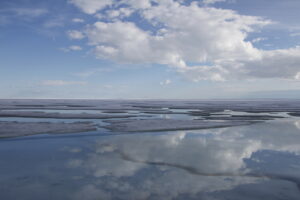
People & Culture
On thin ice: Who “owns” the Arctic?
As the climate heats up, so do talks over land ownership in the Arctic. What does Canadian Arctic Sovereignty look like as the ice melts?
- 4353 words
- 18 minutes
This article is over 5 years old and may contain outdated information.
Science & Tech

In the fall of 1947 Tom and Jackie Manning decided their dinner table was too small. The experienced Arctic travellers couldn’t seat any more of the guests who often gathered in their Ottawa home to talk about the North. So, along with Tom’s fellow Arctic explorer Graham Rowley and his wife Diana, a geographer and editor, they decided to form a club. They called it The Arctic Circle.
Canada had long neglected its Arctic, but by 1947 was beginning to play catch-up. “It was a time in which the area was really opening up, in part because the Cold War had just begun, and tensions between Russia and the West were on the rise,” says The Arctic Circle past president, geographer Chris Burn. “People realized that if Russia was ever to invade North America, one of the potential routes would be over the top of the continent, and hence there was a flurry of mapping and exploration.”
The Arctic Circle provided a place where people involved in the Arctic — in research, government, the military and private enterprise — could share information and discuss plans. Those early meetings “had a huge impact on the development of federal policy and science regarding the Arctic,” says Burn.
Almost 70 years later the Arctic Circle is still going strong. On April 8, 2014, it marked its 500th meeting with an evening event featuring Inuit throat singing, Arctic food and the Circle’s hallmark — informed and lively discussion.
The Arctic Circle’s meetings, held monthly from October through April at the Royal Canadian Air Force Officers’ Mess in Ottawa, are relaxed and convivial and feature a talk with informal discussion afterward. The list of topics covered since 1947 reveals the issues of the day: oil exploration, icebreakers, sovereignty, climate change, Inuit society (a number of Inuit leaders have spoken to the Arctic Circle) and much more.
The only requirement for membership is an interest in the Arctic. Members have included people such as Henry Larsen, who as captain of the RCMP vessel St. Roch made the first crossing of the Northwest Passage in both directions; Moira Dunbar, a glaciologist, co-author of Arctic Canada from the Air, and one of the first women to fly over the North Pole; and James Houston, who played a key role in popularizing Inuit art. Many other members have made — or are still making — important contributions to the North.
You’ll also hear some good tales at The Arctic Circle, says Burn, who as a past vice-president of The Royal Canadian Geographical Society is one of the many Circle member with strong ties to the Society. “Some of our most popular lectures are from bush pilots, ship captains and the like, who recount their adventures and near misses in the Arctic.” Though much has changed since The Arctic Circle began, its members’ love of the Arctic, and their impressive contributions to knowledge of Canada’s North, have held steady.
For more information about the Arctic Circle visit thearcticcircle.ca.


Are you passionate about Canadian geography?
You can support Canadian Geographic in 3 ways:

People & Culture
As the climate heats up, so do talks over land ownership in the Arctic. What does Canadian Arctic Sovereignty look like as the ice melts?

Environment
The uncertainty and change that's currently disrupting the region dominated the annual meeting's agenda

Environment
The Royal Norwegian Embassy and the Royal Canadian Geographical Society teamed up for two days of talks on the future of the Arctic and the “blue economy” in Norway and Canada

Environment
Warming trends continue due to human-caused climate change